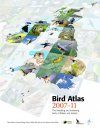![Birds of Meirionnydd / Adar Meirionnydd Birds of Meirionnydd / Adar Meirionnydd]()
Click to have a closer look
About this book
Related titles
Recommended titles
About this book
Language: Bilingual in English and Welsh
The records included in the systematic list are those recorded in the vice-county of Meirionnydd up to 31st December 2011.
Every tetrad in Meirionnydd, as well as the other North Wales counties, was visited by fieldworkers between April and July diring the period from 2008 to 2011, with additional visits to some tetrads in 2012. The results of this fieldwork give the most complete picture yet obtained of the county's bird population.
Customer Reviews
Distribution Atlas
Out of Print
By: Rhion Pritchard(Author)
220 pages, 8 plates with colour photos; b/w illustrations, tables
"This is a compact and affordable addition to the avifaunas of North Wales. The former county of Merioneth has been, under its Welsh name, a District of Gwynedd since 1974, which was also the date of the last book on its avifauna (Birds of Merioneth). Its author, P. Hope Jones, then complained that the county had been passed by since 1945, a ‘murky backwater’ in the flowing tide of post-War birdwatching, but recording has much improved since then under the aegis of the Cambrian Ornithological Society. The author has followed the sensible pattern set by Ceredigion (Roderick & Davis 2010; reviewed in Ibis 153: 457) in presenting for commoner species a regular division between ‘Historical’ and ‘Recent’ records, but he has enhanced these summaries of recent BBS and National Atlas results, though without actual maps.
Meirionnydd is a mountainous land, with rough pastures, little arable, ample coniferous forests, and three large and many small lakes, falling westward to a sandy coast with three estuaries. Its most famous site is the rock of Craig yr Aderyn, with its Cormorants Phalacrocorax carbo and Red-billed Choughs Pyrrhocorax pyrrhocorax. The mysterious Welsh Twites Carduelis flavirostris have almost vanished, and Lapwing Vanellus vanellus and Curlew Numenius arquata have seriously declined, but Goosander Mergus merganser and Red-breasted Merganser Mergus serrator are now regular breeders, as are Hen Harrier Circus cyaneus and Osprey Pandion haliaetus.
As the title announces, the coverage is of the Watsonian Vice-County, and thus includes the northern section of the Berwyn Mountains, now in Denbighshire."
- D.K.B., Ibis 156(1), January 2014




































